MiGs, Stars & Magic Books: A Brief History of Trespassing in Moscow
An illustrated guide to urban exploration in the Russian capital.
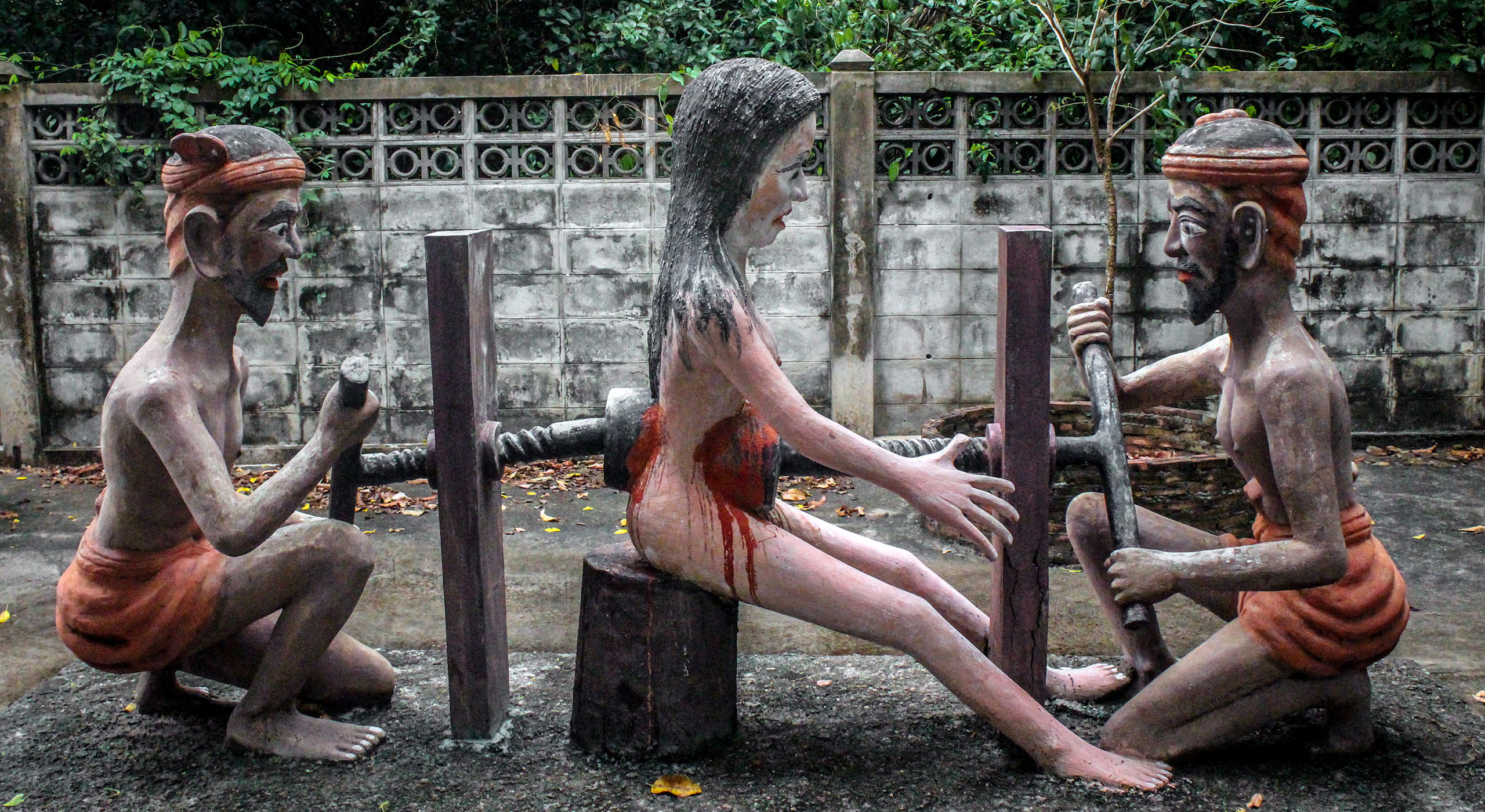
10 June 2013
Hidden away down an overgrown road, in a village not far from Bangkok, there lies a curious museum known to many as the ‘Thailand Hell Horror Park’. Built adjacent to a local temple, the Wang Saen Suk Hell Garden – as it is correctly named – brings to life Buddhist teachings about the torments of the underworld, in a series of increasingly gruesome scenes. Curious to learn more, I set out in search of Hell.

I first came across photos from the Wang Saen Suk Hell Garden a couple of years ago, after they had appeared in The Fortean Times. When I finally got to Thailand for myself, it was right up there on my ‘to-do’ list. After a little digging around I managed to find an address for Wang Saen Suk, apparently located at Sai 2, Soi 19, Saen Suk.
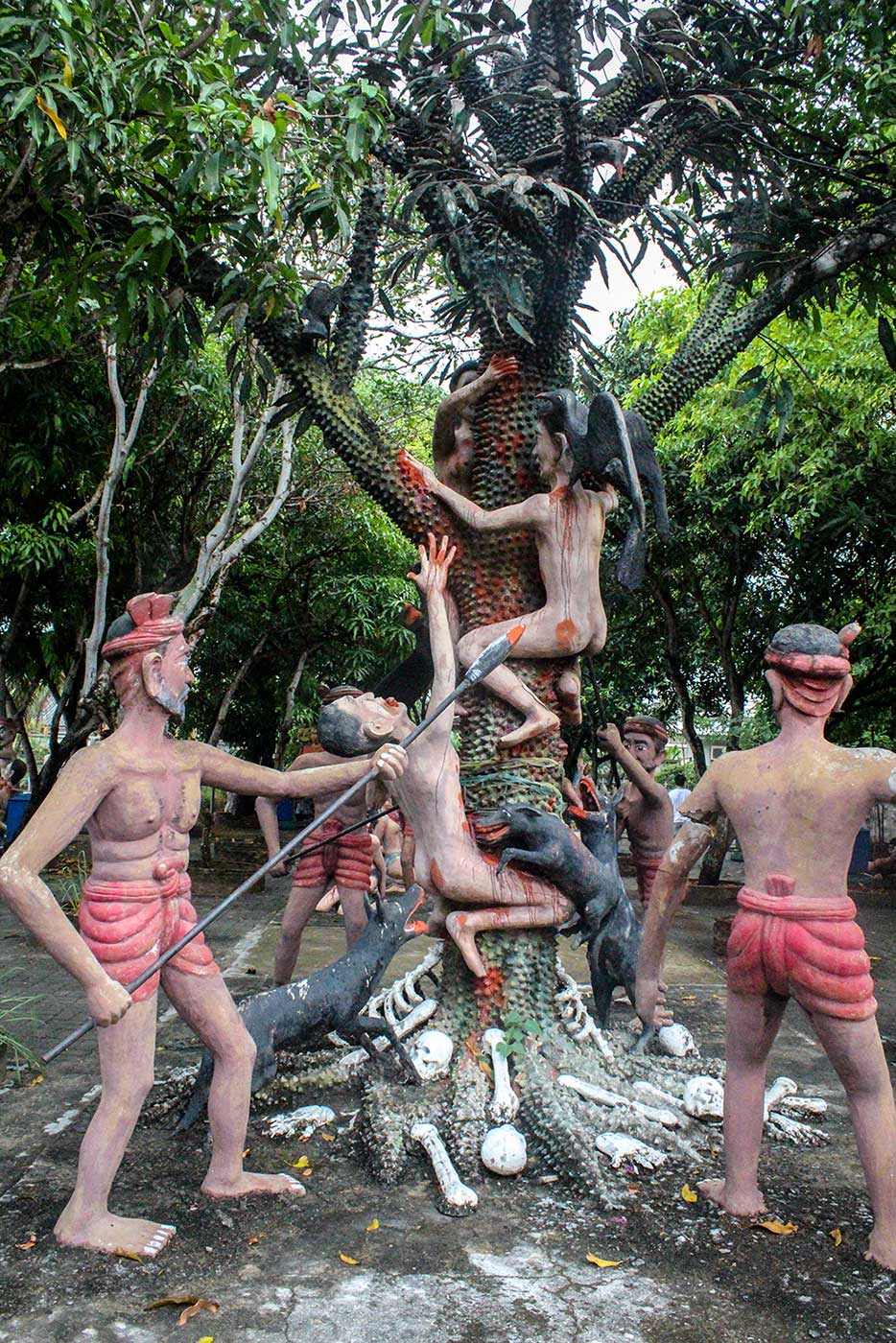 The village of Saen Suk is located close to Chon Buri – around 100km southeast of Bangkok – and while its pleasant beaches do attract their fair share of domestic tourism, the majority of foreigners pass this spot by in favour of nearby Pattaya or the spectacular islands to the south.
The village of Saen Suk is located close to Chon Buri – around 100km southeast of Bangkok – and while its pleasant beaches do attract their fair share of domestic tourism, the majority of foreigners pass this spot by in favour of nearby Pattaya or the spectacular islands to the south.
I didn’t have much in the way of a plan; I simply woke up early one day and headed down towards Bangkok’s hectic bus station beside Victory Monument. Getting there seemed to be a relatively simple affair. Regular coaches run from the capital to the infamous sex-tourism hotspot of Pattaya, and they would all be passing Chon Buri on the way. From there I guessed I’d taxi it to the Hell Garden. Getting back worried me more, but I decided to think about that later.
Sure enough, by 9am I was wedged into the back of an old bus between a couple of elderly Thai women, with a breakfast of noodles and a syrupy iced coffee. The journey took us just short of two hours, escaping the horrific Bangkok traffic to leapfrog the beach resorts which lie scattered along the coast east. One-by-one the other passengers got off, until I was alone with the driver. Every few minutes I’d ask him where we were, terrified of missing my stop.
“This Bang Saen!” he suddenly declared, then, pointing off to the right, “Saen Suk!” He hadn’t heard of the Hell Garden (and my graphic mimery wasn’t helping), but I only had to get to Saen Suk and look for the palace, or “Wang”. I thanked him and hopped off the bus – into a bustling street of Chinese markets.
Getting from Bang Saen to the Hell Garden was not as easy as I had imagined. Taxis seemed non-existent here, so for the next four hours I walked up and down rural lanes flanked with high hedges, beside highways and past grocery shops, barbers and massage parlours.
To make things a little more interesting, the weather was fast deteriorating. As the locals were dashing for cover, many of them looked out in puzzlement at the stupid farang who had gotten lost in a fishing village during a thunderstorm.
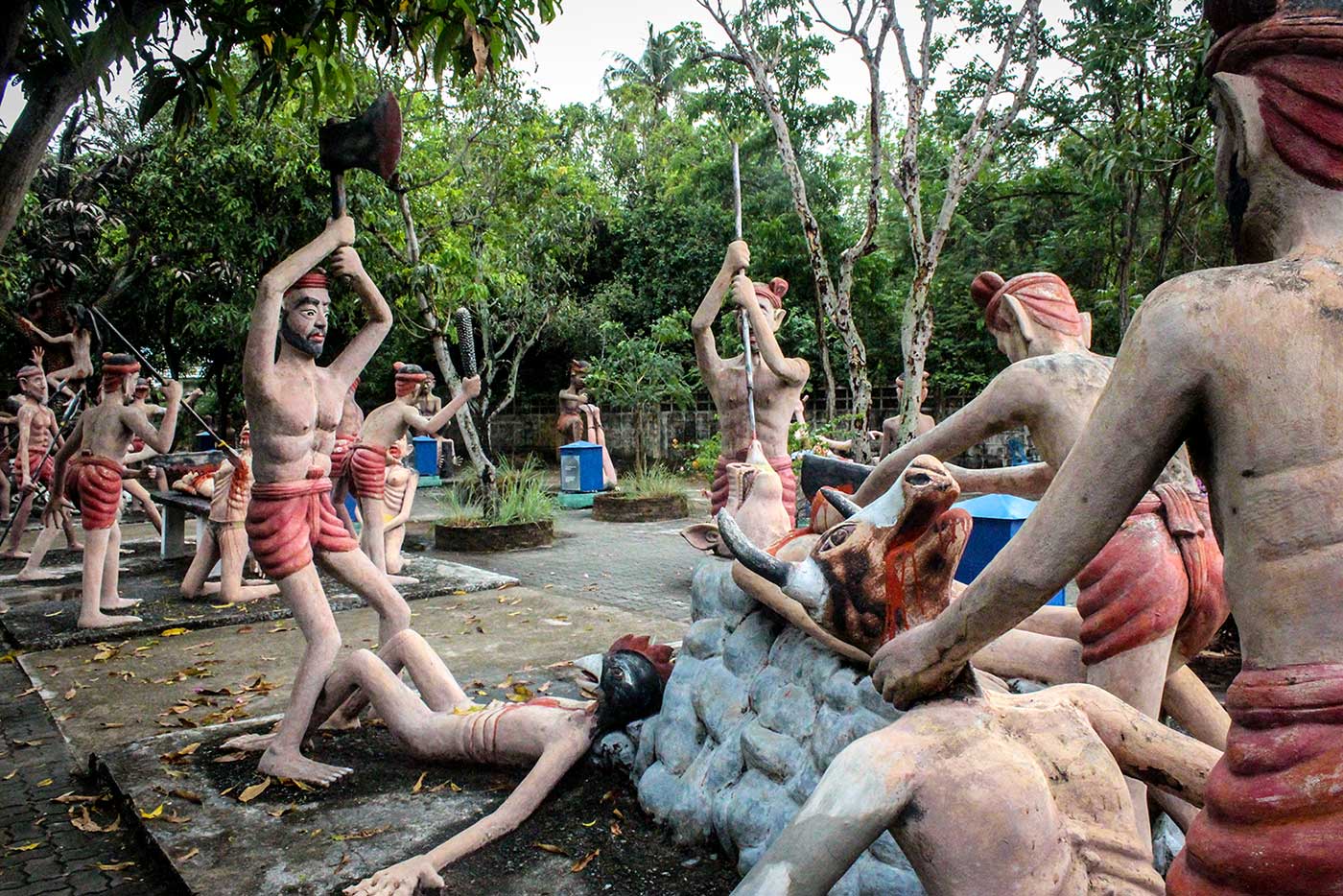
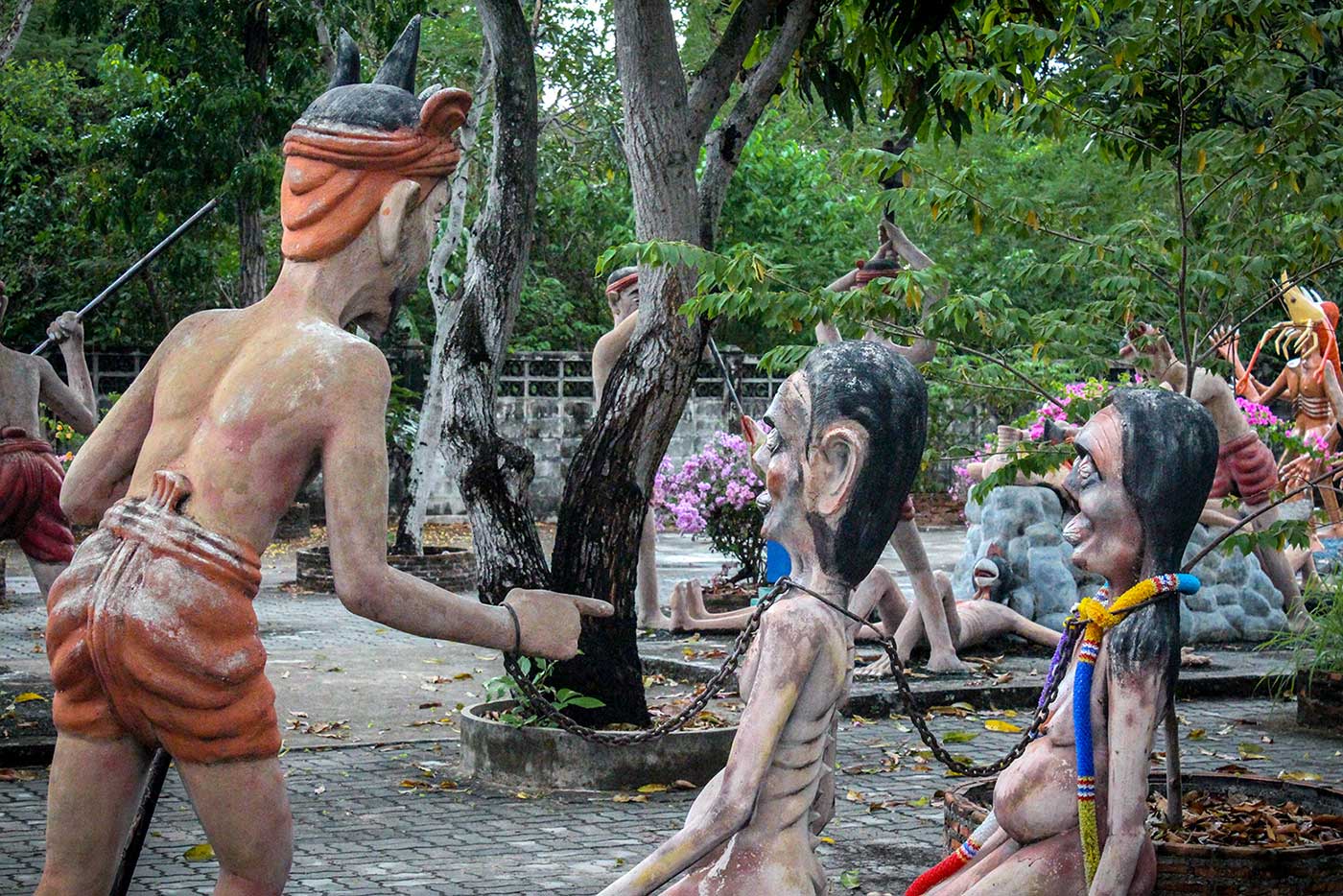
“Go home!” a mechanic laughed at me, when I stopped to ask directions. “Khaosan Road that way!”
He was pointing at Bangkok, and its heaving tourist district. Later I stopped for a coffee at a roadside shack, and the woman running it made conversation while I drank. She spoke in Thai, and I understood around four words in as many minutes – but it was somehow flattering that she would try speaking to me in her own language. I did have to text a Thai friend to get the word for ‘toilet’ however… that was one thing I wasn’t going to mime.
It was getting late in the afternoon by the time I reached Bang Saen Beach. I had been following a map copied by hand from the Internet, but it seemed to bear less and less resemblance to the arrangement of roads in reality. I was tired and soaking wet, wondering if I would ever find this place. I got talking to a bunch of youths outside a 7-Eleven. At first they made the same mistake that others had – directing me to the temple, or Wat Saen Suk instead of Wang Saen Suk. The palace was new to them.
I was almost beyond hope when a nearby man suddenly joined the conversation. He was smoking in the rain, his feet propped up high on the handlebars of his motorbike.
“I take you to Hell for 20 Baht,” he said.
My Virgil left me by the entrance, where a great Buddha sat in watch over the gates of hell. From here it looked unremarkable; there were life-sized sculptures of men, women and animals, grouped to portray scenes of religious significance. A man was cutting off his hair in one diorama, while another man, presumably a saint of some sort, was slaying some mean-looking crocodiles. Here and there monks floated about, their orange robes wet from the storm, while a sign on the wall proclaimed, “Welcome to Hell!”
I followed the path around a corner, when suddenly the space ahead of me was opened up into a surreal tapestry of pain.

Two vast figures dominated the clearing, the emaciated forms of a man and a woman. At their feet, four sinners were boiling alive as guards jabbed at them with spears. Around the cauldron and the giants, there danced 21 figures – all at a similar height to me. Their twisted human bodies were conjoined with the heads of animals, and arrayed in a variety of threatening poses: lunging, reaching and clawing, or prancing about like fools.
In Buddhism, Hell is known as ‘Naraka’. It’s not eternal damnation in the Abrahamic sense, but rather the punishments of Naraka continue until the sinner’s negative karma is spent. Texts such as the Devadūta-sutta (a part of the Pāli Canon) give descriptive accounts of the tortures conducted here, which are decided by the particular crimes of the individual. The tormented are not ‘cast’ into hell, as is the case in other religions; but rather, it is the weight of their negative karma that brings them here.

According to the Traiphuum Phra Ruang, the newly-dead are brought before the ‘Death King’, Phya Yom. It is Phya Yom who informs you of your fate, after comparing your list of good deeds (inscribed on a gold plate) against any bad actions you have committed in life (listed on a scrap of dog skin).
The demon closest to me had the head of a savage pig, and a plaque between its feet that read:
“Ones who make a corruption are punished in the hell, they are named as the spirits of the pigs.”
I walked through the dancing rows, reading the inscriptions as I passed. The ungrateful become tigers, the jealous rabbits, and those who instigate brawls become ducks. Stealing aquatic animals earns you a fish head, while those who steal cooked rice are named as the spirits of the birds. All are punished in the hell.
Ones who sell the habit-performing drugs are punished in the hell, they are named as the spirits of the cows.

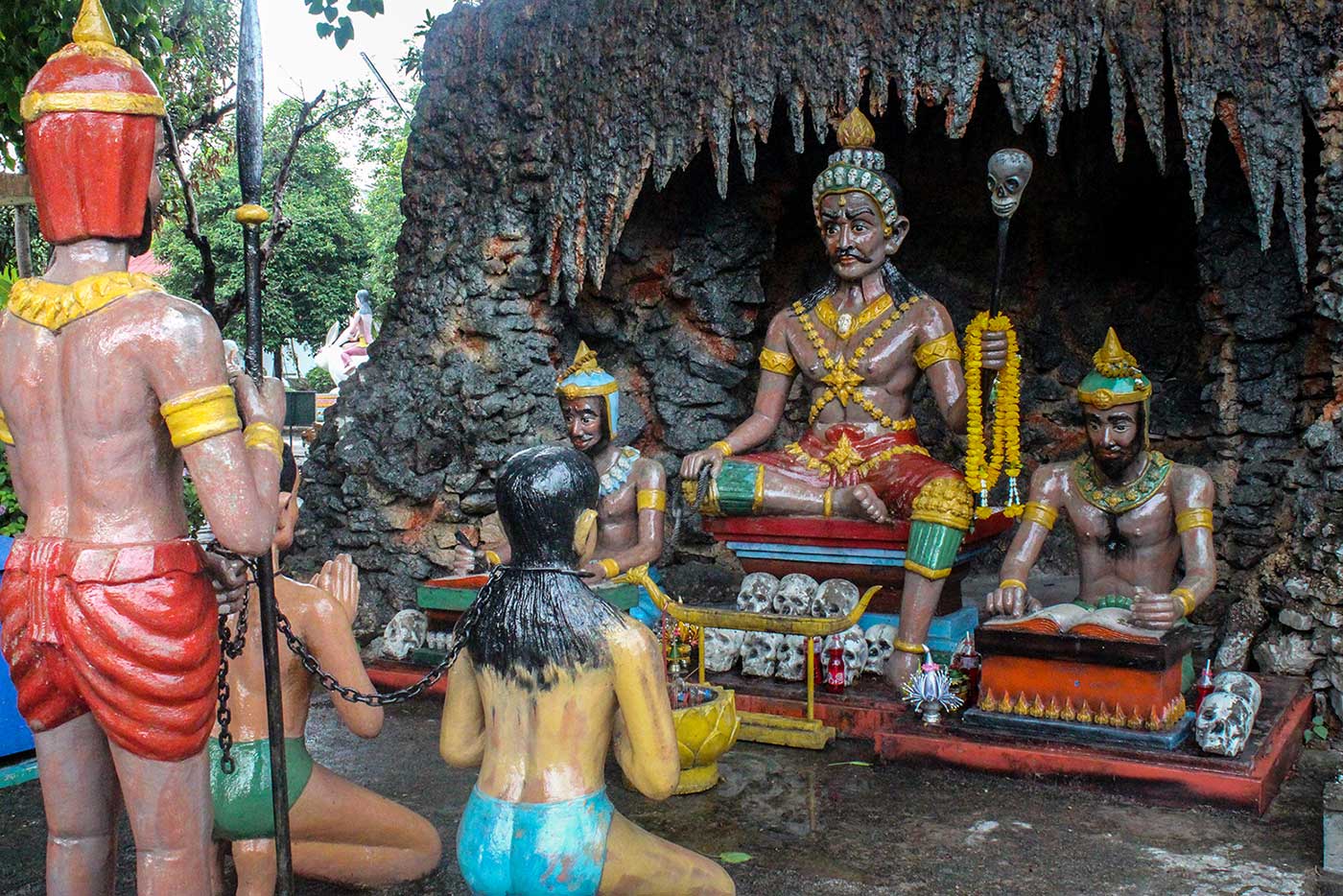
Phya Yom, the Death King, was seated in a grotto to my left. Before him stood two freshly deceased souls, chained about their necks and awaiting judgement.
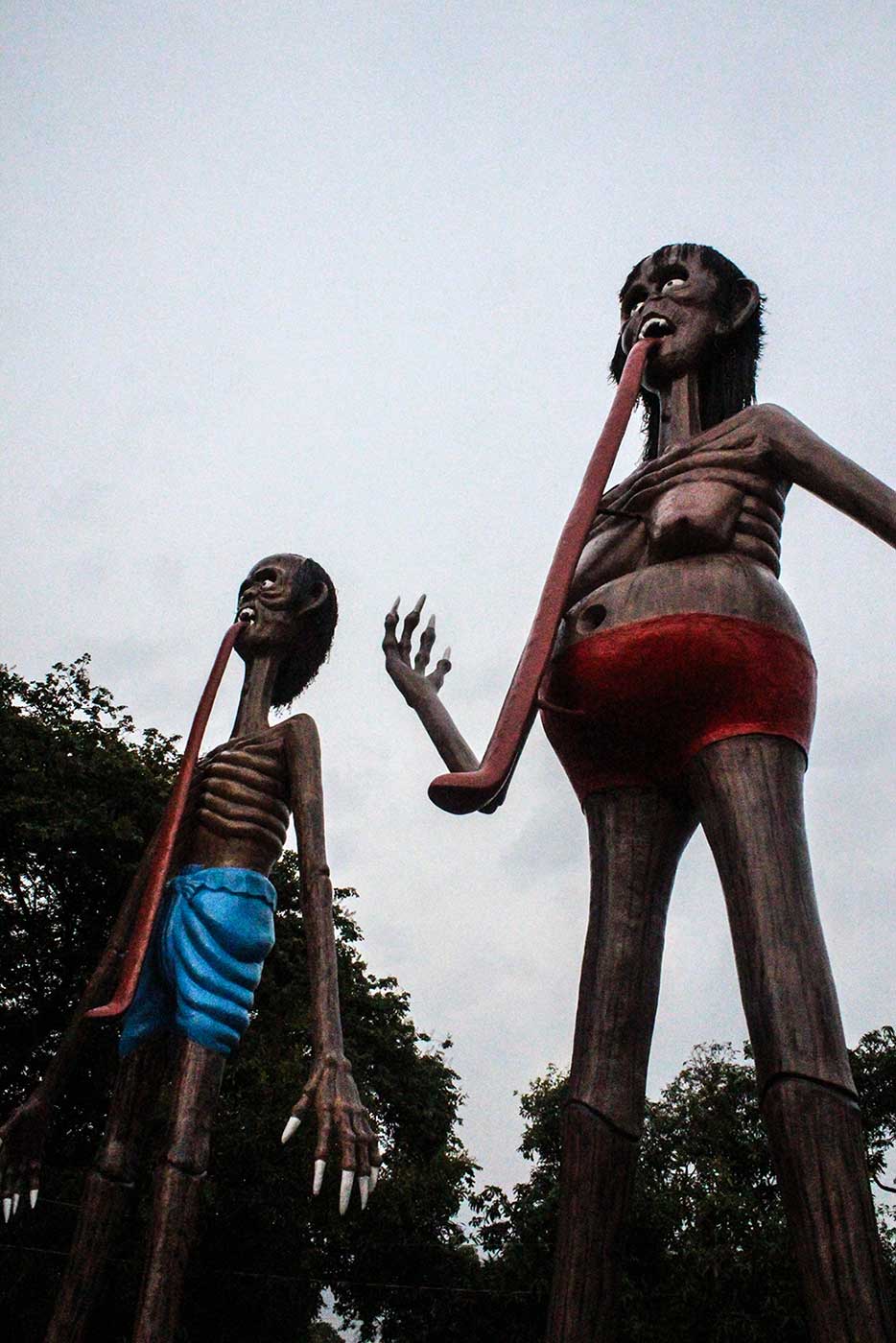 I wanted to find out more however, about the two figures that towered over all else: a male and a female form, with skeletal features and stretched tongues hanging halfway to the ground. A donation box was placed at the feet of each giant, while signs in English explained the fate of these two tortured beings. They had transgressed the five sacred precepts of Buddhism, and “plunged themselves into the four Causes of the Misfortunes”. Namely, “the Connoisseur of Women, the Habitual Drinkers, the Habitual Gamblers the Fellowship with the knaves and behaving against the virtue or the moral principles”.
I wanted to find out more however, about the two figures that towered over all else: a male and a female form, with skeletal features and stretched tongues hanging halfway to the ground. A donation box was placed at the feet of each giant, while signs in English explained the fate of these two tortured beings. They had transgressed the five sacred precepts of Buddhism, and “plunged themselves into the four Causes of the Misfortunes”. Namely, “the Connoisseur of Women, the Habitual Drinkers, the Habitual Gamblers the Fellowship with the knaves and behaving against the virtue or the moral principles”.
These colossal figures were named as ghosts. The male was ‘Nai Ngean-Nai Ngean’, guilty in life of vice and disorderly conduct. The female ghost – ‘Nang Thong-Nang Thong’ – had made mistakes of “sexual intercourse, misconduct, mind without morality”.
There are many ghosts described in Thai folklore; often inhabiting forests or coastal areas, they range in personality from the highly aggressive to lost and lonely souls. Nai Ngean and Nang Thong seemed to fit the description of Preta; or, ‘the hungry ghosts’.
The concept of preta is common to Buddhist, Sikh, Hindu and Jain texts. These are spirits who have been greedy or jealous people in life, and by punishment are afflicted with insatiable hungers in the afterlife. In many traditions the object of their hunger is something repulsive, such as human faeces or cadavers.
Stories about the preta vary from culture to culture. Generally though, they are characterised as having great height combined with mummified skin, skeletal limbs and distended bellies. Their necks are long and thin, too narrow to allow them to fill their stomachs – and serving as a visual metaphor for their hunger.
Preta are highly sensitive to heat and cold, and unlike the tormented souls of hell they are free to wander the earth – forever searching for nourishment. Some traditions say that the ghost’s food will burst into flames as it tries to consume it; other sources describe preta as being invisible, or visible only to humans in abnormal mental states.
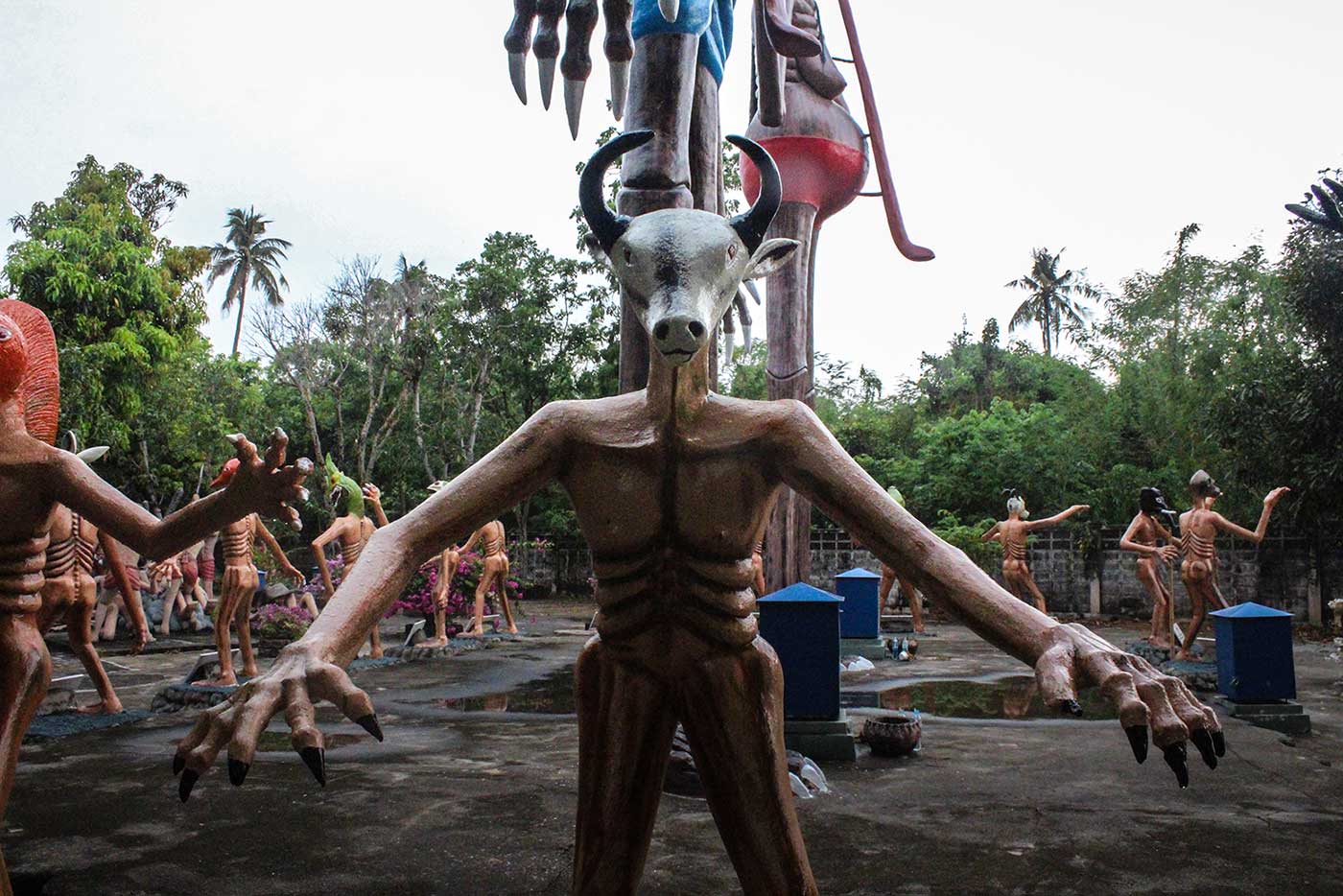
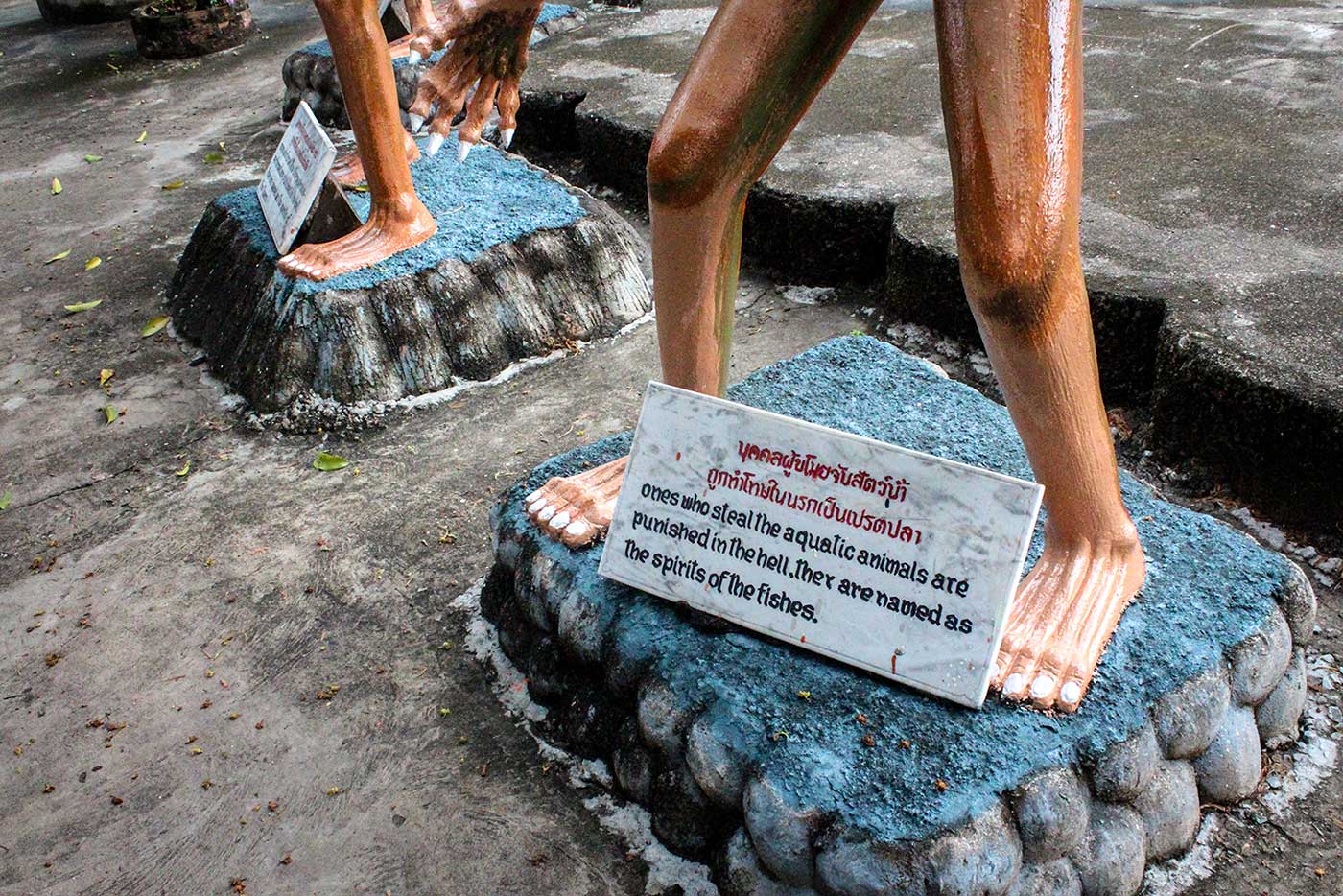
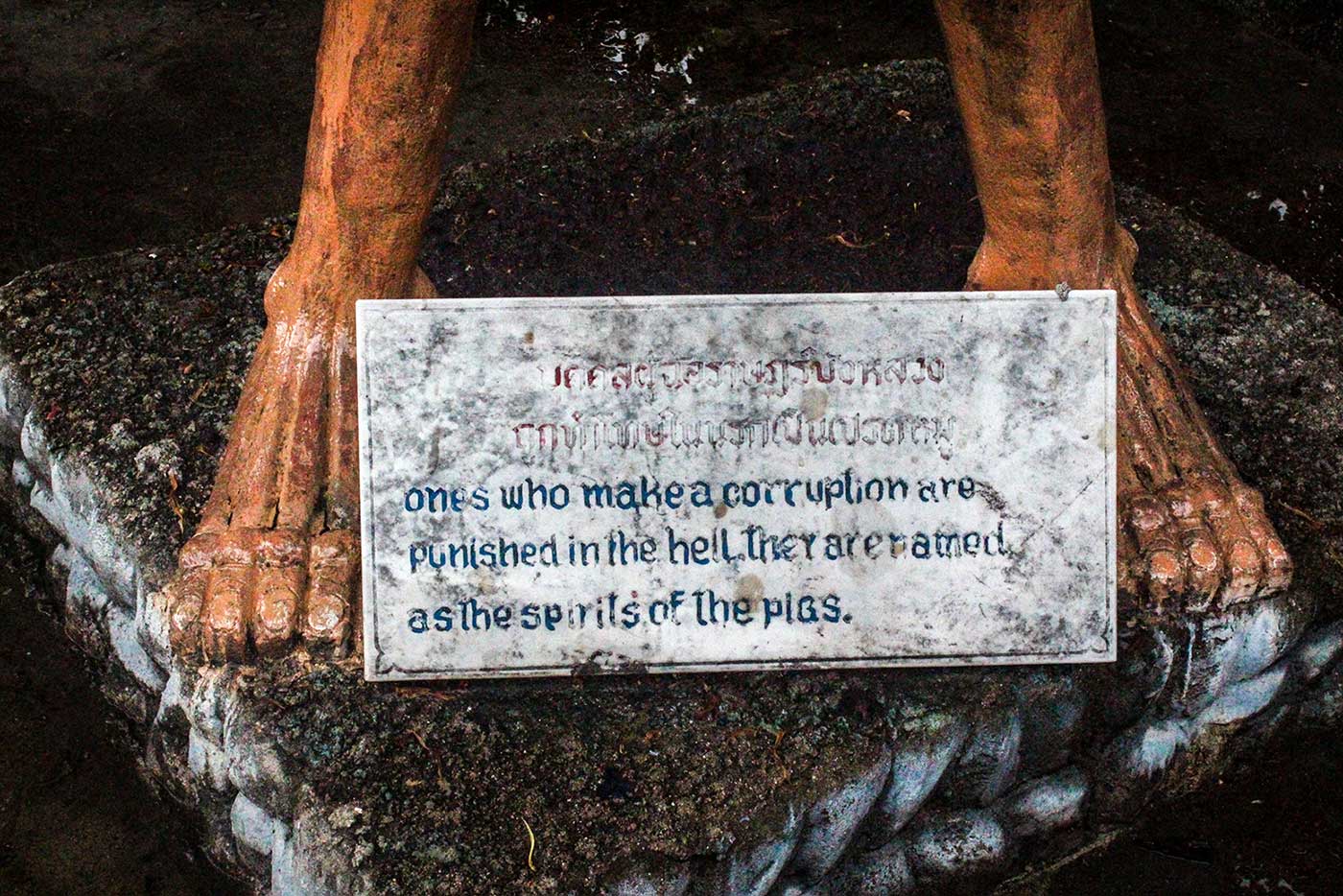
Behind the hungry ghosts I examined another row of demons, some with less mammalian faces: a snake, a dragon, a lizard and a lobster.
I learned that those who exploit and cause suffering to others are named as the spirits of the dogs; vandals are rats and tortoises undermine the authority of others, while those who destroy the areas of wilderness are named as deer.
Ones who are employed to put fire on the others properties are punished in the hell, they are named as the spirits of the snakes.
Thailand has a number of Hell Gardens, but the Wang Saen Suk Monastery Garden is the largest of them all. Entering the garden proper, I passed a sign which warned;
“If you meet the Devil in this life, don’t postpone merit-making which will help you to defeat him in the next life.”


Naraka consists of eight large pits, each of them attached to a further 16 areas, giving a total of 136 pits altogether. These regions vary in terms of punishment, and individuals are assigned to a pit based on the nature of their transgressions.
This formulaic system of torture shares much in common with the Christian traditions illustrated by Dante’s Divine Comedy; unlike Dante’s own Inferno however, the dead may be reborn from Naraka once their punishment has finished. Only one pit differs, and that is Avici: the ‘non-returning hell’. This deepest region of the underworld is cold rather than hot like the others, and reserved for those who take the life of their parents, a Buddha or an enlightened ‘Arhat’. Souls in Avici remain in torment until the birth of a new Buddhist era.
While Abrahamic religions focus on the Ten Commandments, the Buddhists live life by a series of ‘Precepts’. According to the Pali Canon the Five Precepts forbid murder, theft, sexual misconduct, dishonesty and drunkenness. There are more precepts besides these however; novice monks must live by a series of 10 precepts, while an adult monk must uphold a total of 227.
As I walked around the garden, I was introduced to the various punishments prescribed for a range of different crimes. Stern men dressed in Buddhist robes were appointed the role of torturers. In the middle of the courtyard some naked figures were climbing up a thorny tree; the dogs of hell harassing them from beneath while ravens pecked at their eyes.
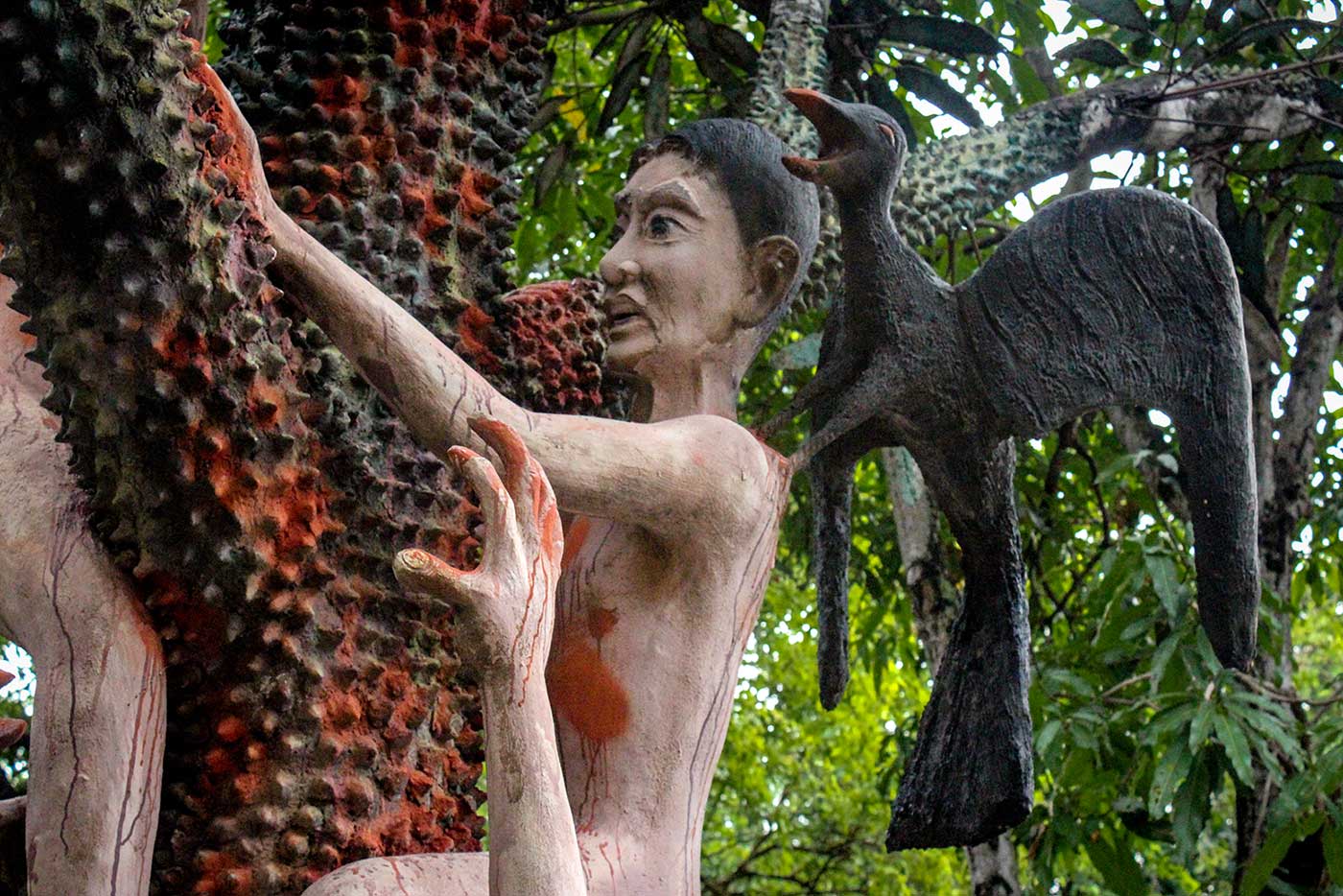
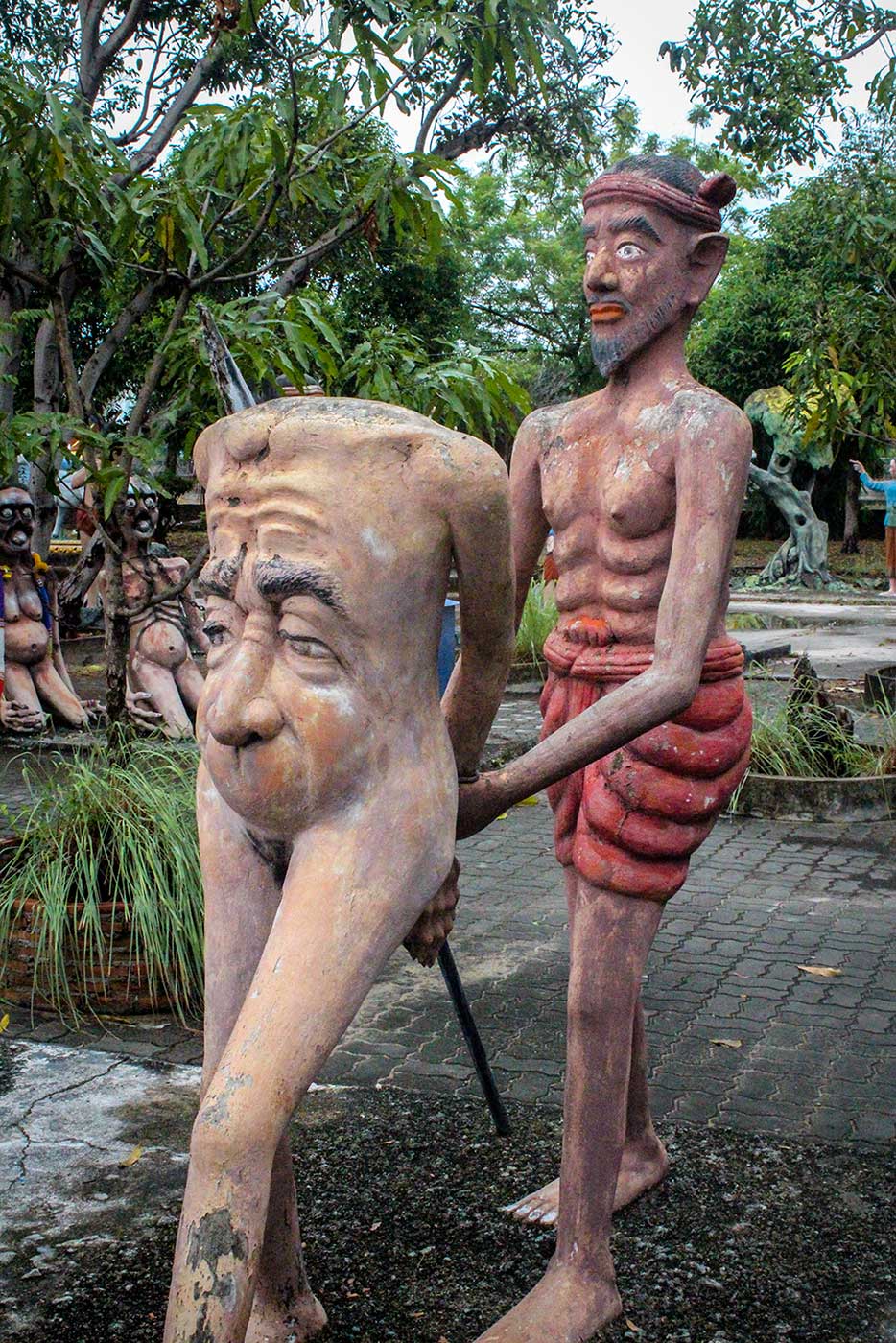 Beside this diorama, a donation box explained:
Beside this diorama, a donation box explained:
“Ones who violate the third one of the Five Precepts “Infringing the sexual intercourse, being paramour with the others’ wives or husbands” receive the results of the bad action as shown in this picture.”
Other punishments included a woman being penetrated with a spear, as recompense for “injection, aborticide, birth control”; “cheating and overreach” were punished with the removal of eyes, while a man who had undermined Buddhism was having his head savagely beaten off with a metal bar.
Some of these punishments were conducted singularly, while others were meted out on larger groups of sinners. One particularly gruesome scene featured a corrupt man and a rice thief (with the heads of a pig and a bird, respectively) being hacked apart with axes; an undutiful ascetic (toad) was having his intestines torn out by a bird, whilst a bull-headed drug dealer had his throat crudely slashed.
A human-headed sinner was being sawn in half beside them, another had a throwing star embedded in his forehead. It was interesting to note one other figure, which bore a strong resemblance to a ‘Blemmye’; a mythical tribe of cannibals reportedly discovered in Africa, headless and with a face growing from their torso. The Blemmyes were described as early as the 1st century AD (“It is said that the Blemmyes have no heads, and that their mouth and eyes are put in their chests.” – Pliny the Elder, c75 AD), and have appeared in notable works of fiction throughout the middle ages and since (for example, “And of the Cannibals that each other eat, The Anthropophagi, and men whose heads Do grow beneath their shoulders.” – William Shakespeare, 1603).


Beside this group an inscription read: “Ones who violate the second of the Five Precepts “Stealing, Cheating or destroying the others’ Properties” receive the results of the bad action as shown in this picture.”
Another scene depicted a woman who had killed her husband (a good father), having a spear thrust through her heart. A woman who had committed the sin of abortion was being slowly crushed in a vice, by two of the hell guards. A nearby rapist had been chained to a post and was having a trident shoved at his genitals.
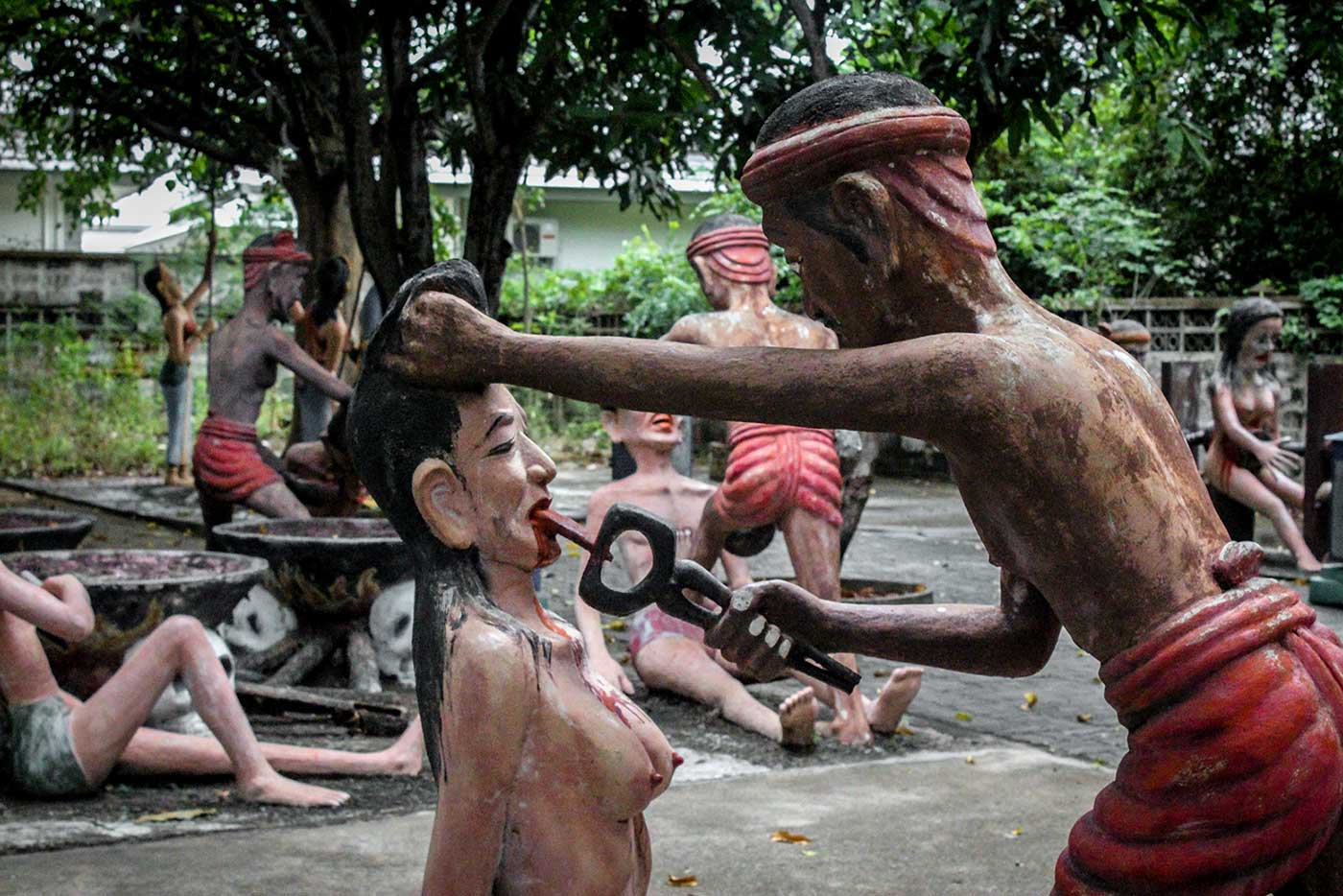
I made my way towards the back of the garden, through the throng of twisting figures. All along I kept spotting faces out of the corner of my eye; many of these cement and plaster figures were surprisingly life-like, and I would often look up to find their eyes meeting mine directly. It was an unnerving sensation.
Other articles I had read about the Wang Saen Suk Hell Garden have reported its popularity amongst Thai families and domestic tourists; the park was abandoned on my visit however, as the rain continued to fall and thunder rumbled ominously over the horizon. Once or twice I saw the giant ghosts lit up by bolts of bright lightning. The electricity seemed to give life – just for a brief moment – to their hungry, withered faces.
At the other end of the garden I met the alcoholics.
These men were still clinging to their bottles, as the hell wardens poured boiling oil down their throats.

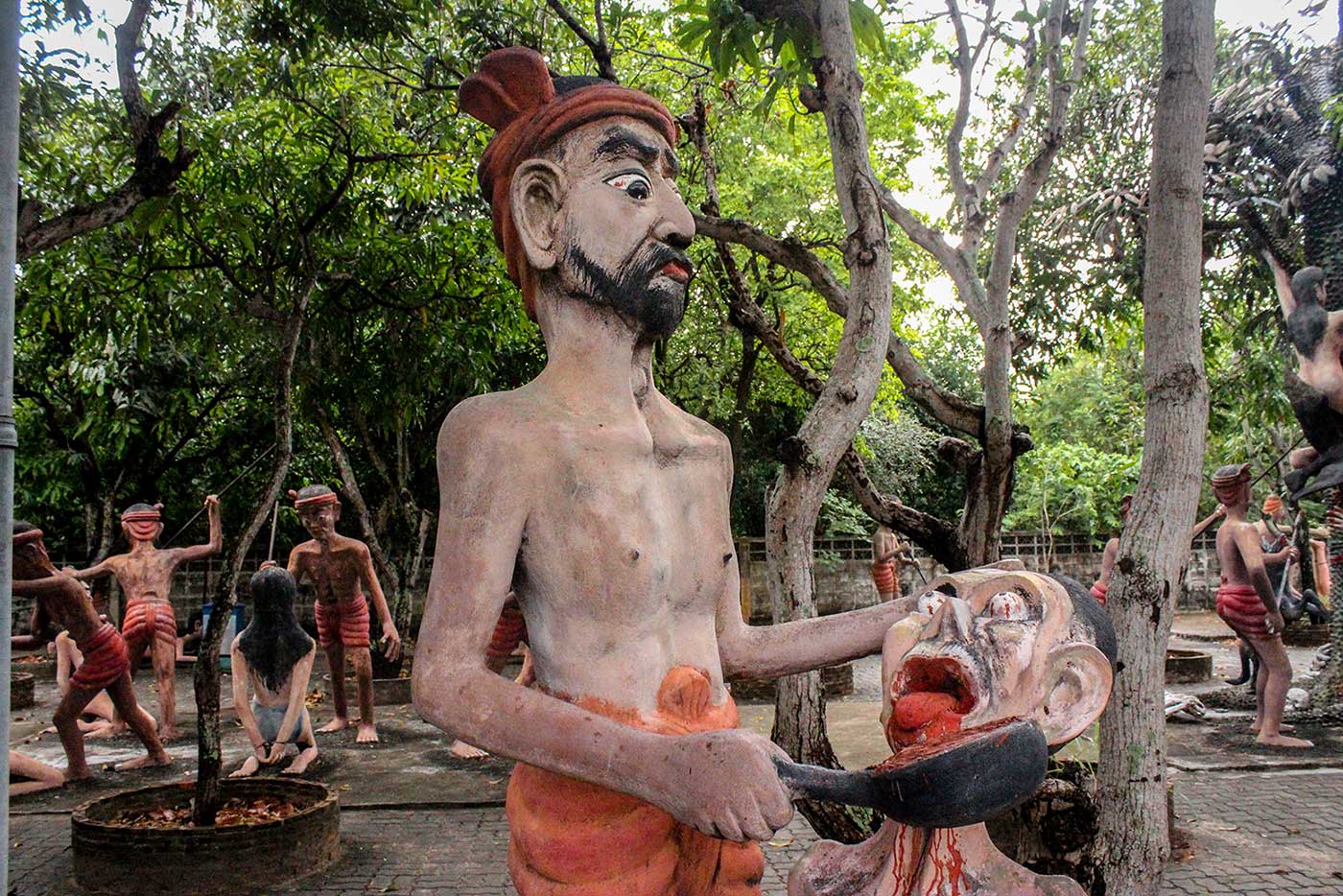
The Wang Saen Suk Hell Garden is not intended merely to frighten, but rather to instruct. In addition to the vicious punishment it details, there are also illustrations of the reward for good karma.
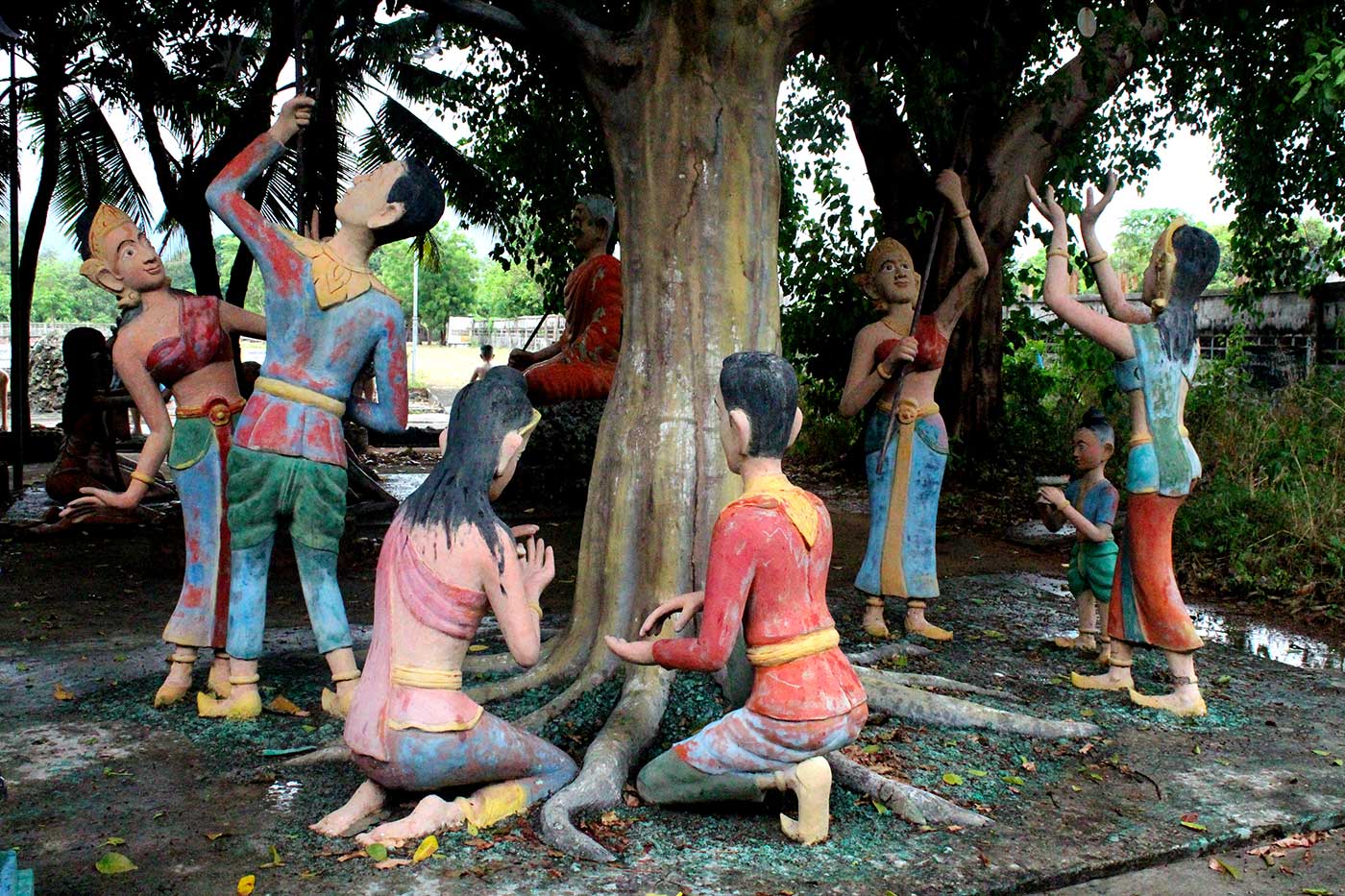
In the furthest corner of the garden, some figures were grouped about a tree. A nearby donation box read: “Ones who give alms and Yellow robs to the Buddhist Monks and build the Buddha’s immages will be born in the religious period of the next Bodhisattaya (Sri – Araya mettaraya). In his religion, there will have been a Kalapapluek Tree growing in the future world yielding which contain every thing one may wish for.”
In fact, having now walked the length of the torture fields it was a relief to find such a positive message waiting at the end. Nearby, in the shade of another tree perched an image of the Buddha.
He smiled down benignly, at the sinners who raised their hands in desperate prayer before him.

I returned towards the entrance, taking an open path that ran parallel to the hell garden. The statues here were not as violent, but rather showed scenes of appeasement. I did note however, that the macabre streak remained… as I contemplated a man peacefully feeding his own entrails to birds.
 Thai Buddhism is fascinating, in that it embraces so many different ideas. Their extended cosmology incorporates an underworld structured much like that of Christianity in the Middle Ages, while themes from Vedic Hinduism have been absorbed into the religion through Cambodia to the north; Hindu gods such as Vishnu and Ganesha are commonly adopted here as personal and household deities.
Thai Buddhism is fascinating, in that it embraces so many different ideas. Their extended cosmology incorporates an underworld structured much like that of Christianity in the Middle Ages, while themes from Vedic Hinduism have been absorbed into the religion through Cambodia to the north; Hindu gods such as Vishnu and Ganesha are commonly adopted here as personal and household deities.
Further illustrating the point, near the exit I came upon a series of twelve figures which corresponded with the signs of the Chinese zodiac. Collection boxes urged for a donation to the visitor’s protective spirit, and so I located mine. The storm was still blowing, and it was just beginning to get dark. Soon I would need to venture out of the relative shelter of the Hell Garden, and try to find a way back to Bangkok. I was going to need all the protection I could get.
The sign read: “Who was born in the year of the pig has an influence on the twelfth, sixth month and year of the small snake. He must drive away the evil spirit by donating one Baht per age.”
I fed a handful of Baht into the slot, and gave a little bow to the female spirit who rode before me upon a giant pig. I wasn’t sure if that was the correct procedure, but it seemed to please a passing monk. I looked up to see him smiling kindly at me, as he arranged potted plants around a nearby Hindu shrine.

I left the Hell Garden behind me, and headed back out towards the main road. It was early evening, and the dark clouds made it appear darker still. I hadn’t seen a taxi all day, and I was already formulating a back-up plan; perhaps the monks would take pity on me, and let me sleep on the temple floor.
As I walked the long road between Wang Saen Suk and the village of Bang Saen, I was joined by a pair of stray dogs who trotted beside me, one on either side. After around 10 minutes I reached the main road, and tentatively waved at the first passing vehicle.
To my surprise, the van pulled over. I tried to mime a bus, alternately asking for “Bangkok,” and the capital’s Thai name, “Krung Thep.” The driver was amused, but he seemed to understand what I needed. He drove me straight to the nearest bus station, and five minutes later I was sitting on a coach headed back to the capital; pondering on the nature of karma.

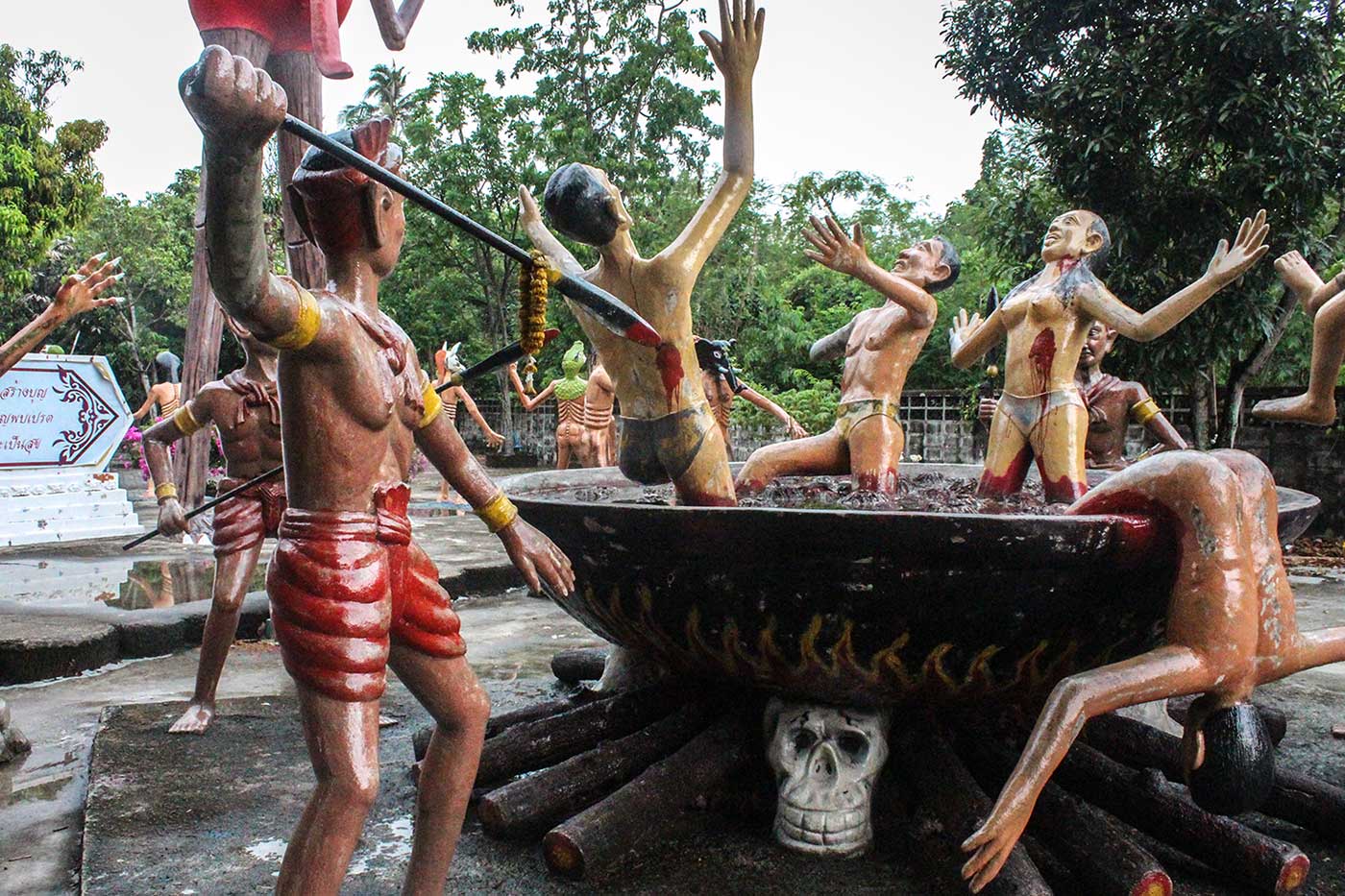

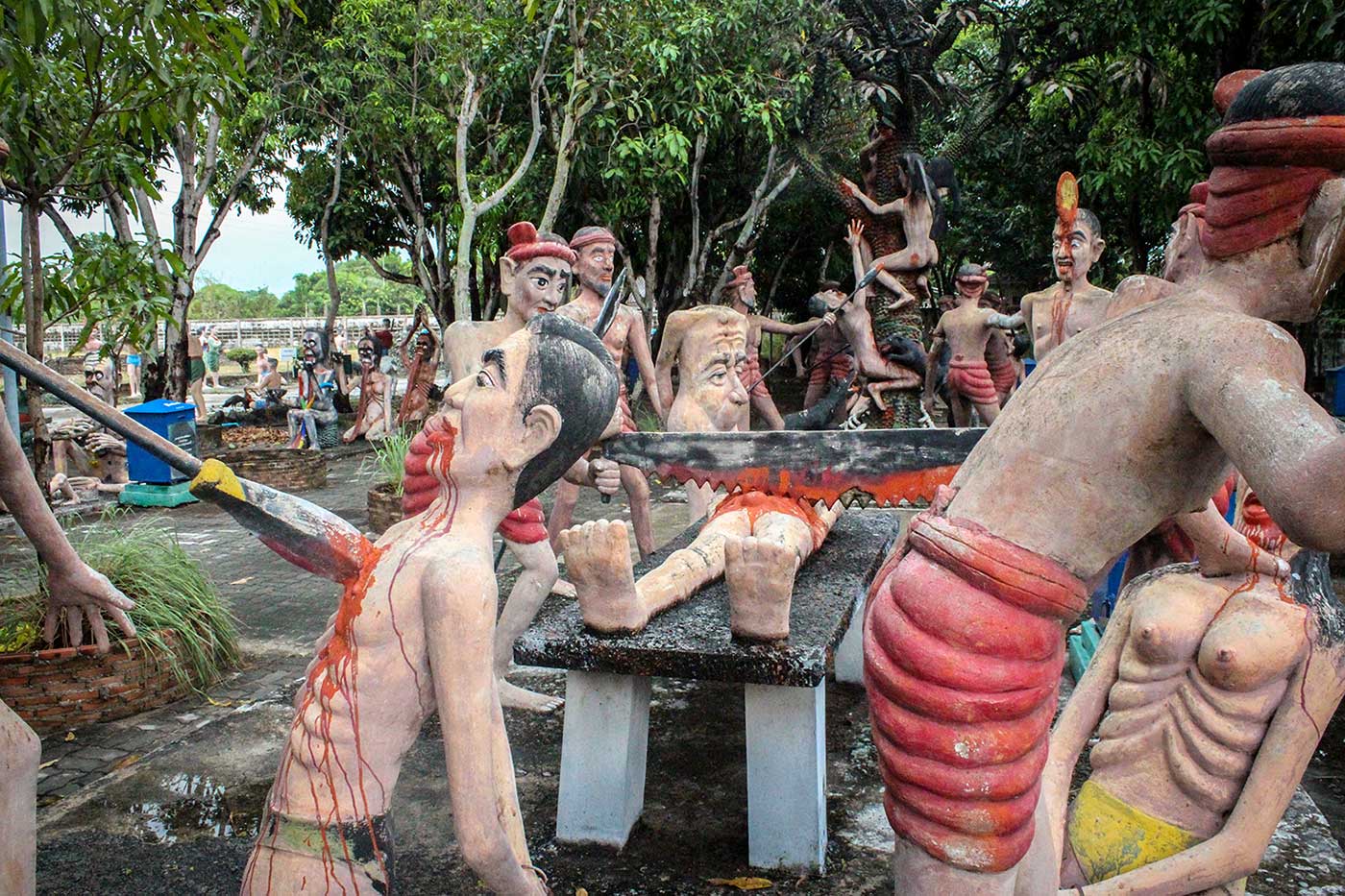
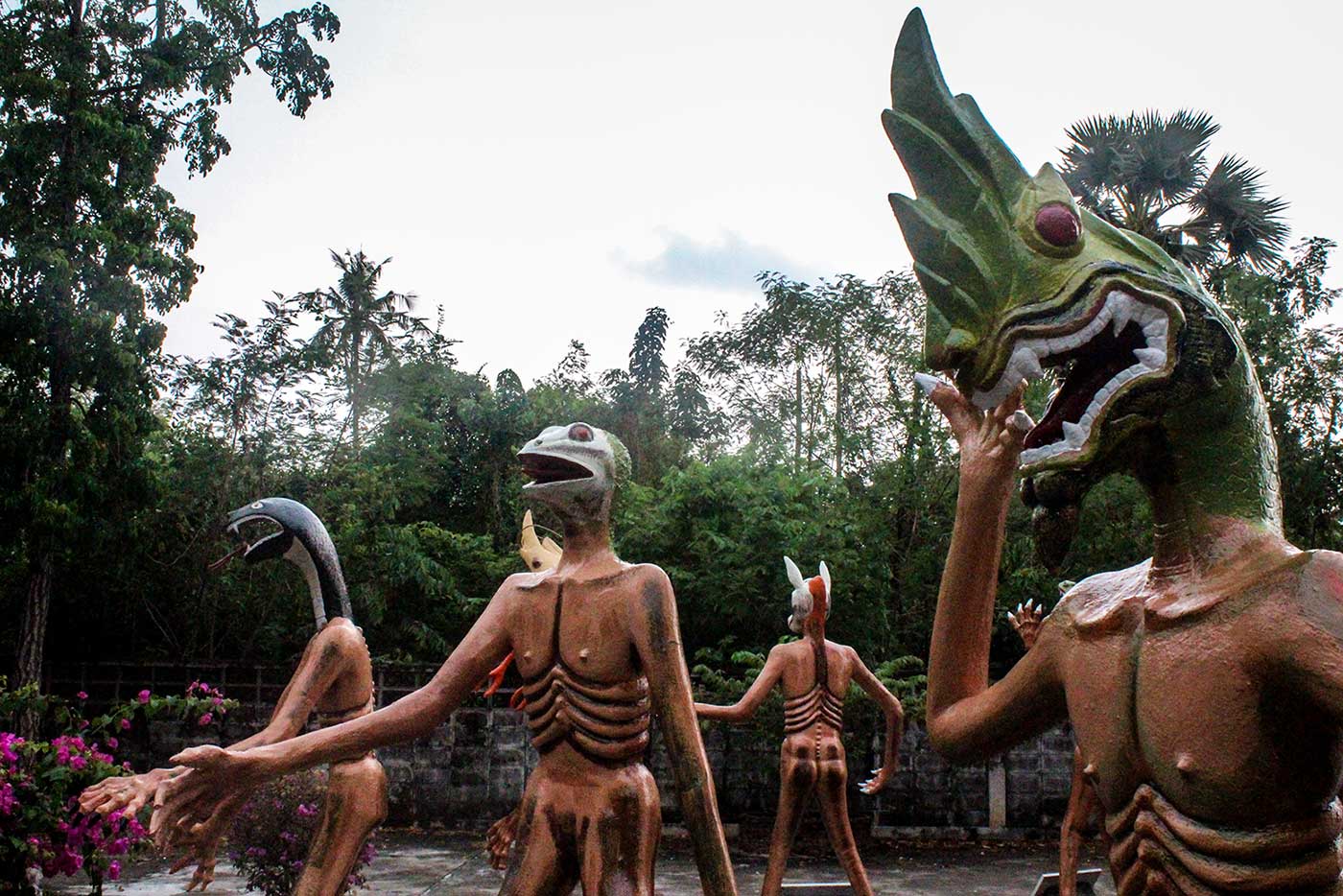

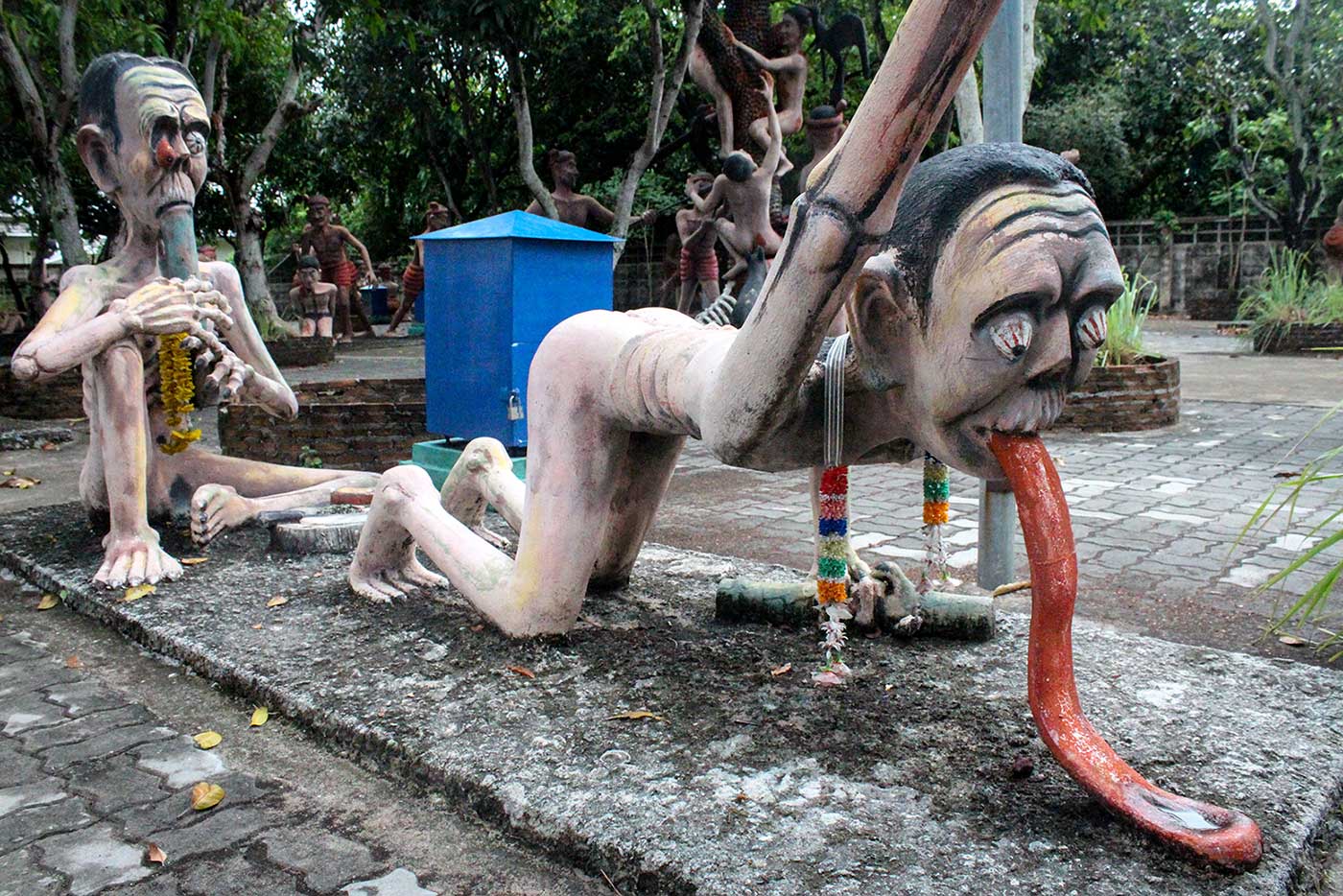

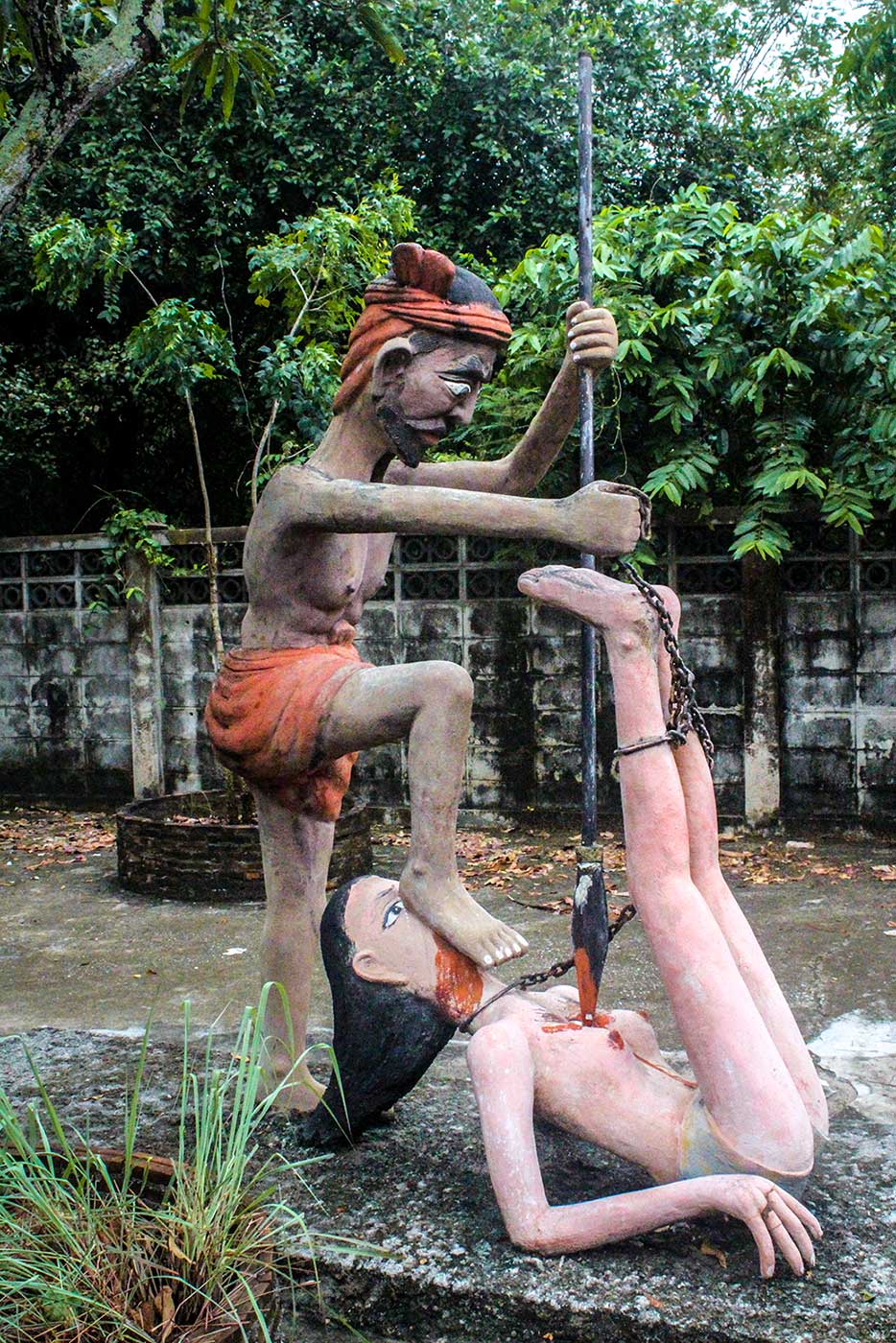


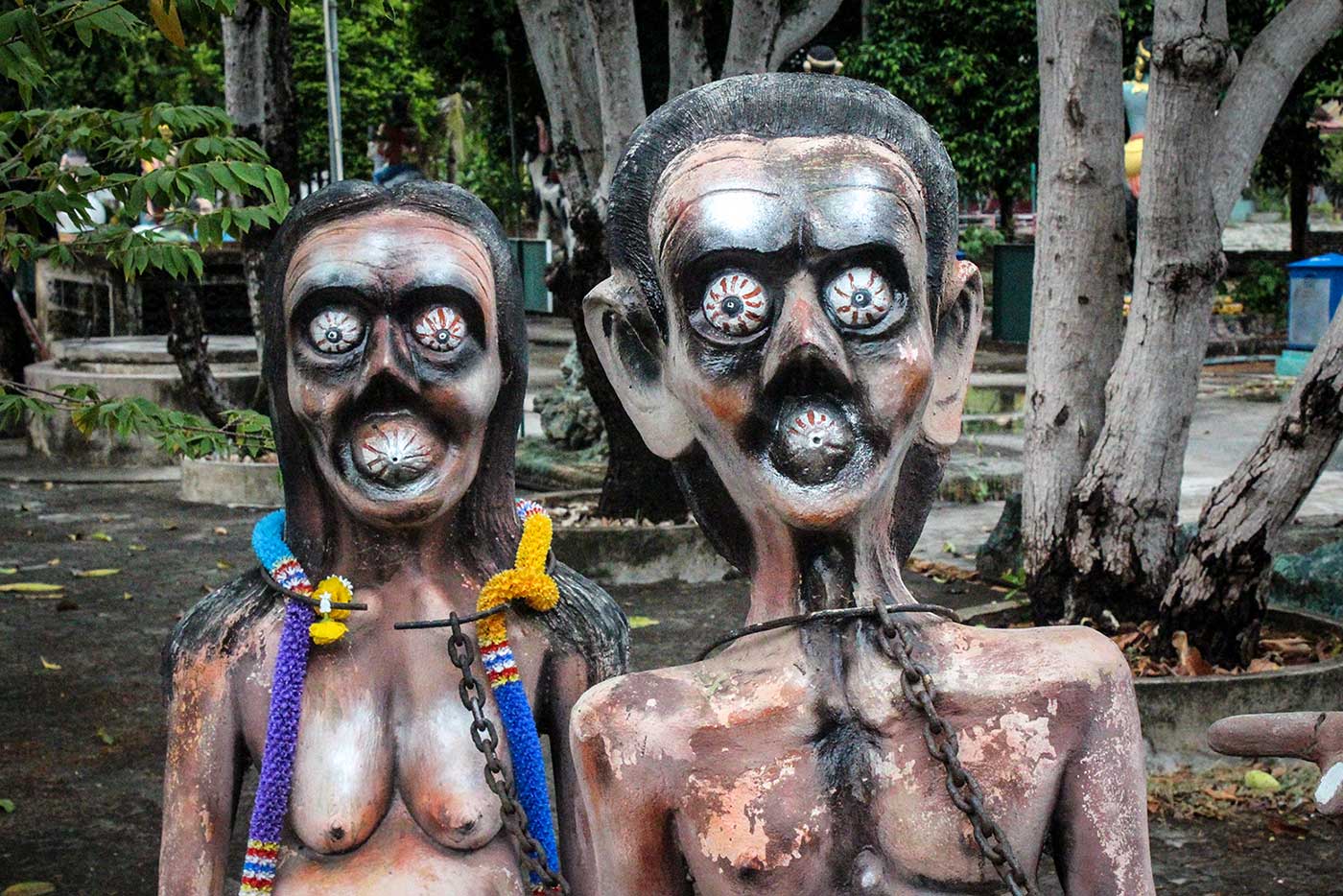





An illustrated guide to urban exploration in the Russian capital.

Poltergeists, ritual murder & a live-in succubus – the 1000-year-old pub with a ghostly reputation

A month-long monument hunt, and what I learned along the way.
In the age of smartphones the getting there part of the story sounds a little comical.
For anyone who wants to see for themselves, just get a minivan or bus from ekkamai to bang Saen. You will be dropped at the highway, where songthaews run to the beach. The hell temple is right there.
Thank you for sharing this Florian! Yes, different times now I guess…
Probably not the place to go after Pattaya… Well…
It actually only 25 min from the pattaya its in Chonburi after all
Thank you for this blog post – I’ve been feeling rather distanced from my practise recently and thus was the reminder I needed.
Looking forward to going there myself.
Wonderful, I’m happy it had that effect.
Hi, firstly thank you so much for posting this story because it’s really help me doing my assignment on this place but I’m a bit curious on how they conserve and preserve the place? and what is your opinion about it?
Thankyou.
Thank you Safika, I’m glad this was helpful. I know my reply is quite late, but if it’s still useful, feel free to send me an email.
Are there any entrance fees?
No, no entrance fees – but the monks encourage you to make donations at various shrines.
there is similar story in hindu mythlogy.if u discharge wrong things u will be punished by yamraj in the Hell( narak)
That’s really interesting to know – thank you, Sudhir.
Read about narayaka & yamadarma….yama is hellking & chitragupta is the sin watcher who has eyes on everyone and when they comit sins they are noted in a book assigned fr each human and appropriate punishment is issued upon death
We have a smilar thing like that in singapore and its like a open air meuseum its about the size of 2 football fields
That’s massive! I need to see this place some day…
We have something similar in Singapore. It’s called “Haw Par Villa”. That place never cease to amaze me no matter how many times I go. They have the 18 gates of hell in a man-made cave. You are able to find goddess statue outside and a lot more unique stuff.
Sounds really interesting – thanks for telling me! I’ll have to go and visit next time I’m in Singapore.
I go there on 2015-05, but i found this place about 2 hours and gonna sunset, finally i found the front gate but not go inside. i suggest people if go there, ensure you locate the place, and the bus stop back to bangkok. print the google map. On Chunburi, not much thai people know english.
I will go Bang Saen again.
Check my blog post about bangkok Ekkamai bang saen
http://cheungtatming.blogspot.hk/2015/05/Day-2-Chonburi-Bang-Saen-Bench-Nana.html
Thanks, Ming – that’s good advice! I wish I had printed a map of my own.
Hi Darmon, I thought I’d touch base following my visit to the Wang Saen Suk Hell Garden yesterday. Perhaps it has become better known since your visit, as our minibus driver from Bangkok dropped us right outside the front gate. I think the statues have been touched up since you were there, too.
I went with a Thai friend and was subsequently able to solve a cuple of the mysteries in your post. In that avenue alongside the Hell Garden, the statues depict the literal meaning of Thai proverbs and sayings, with the symbolic meaning explained on the signs. So, the guy feeding his entrails to the crows depicts the saying, ‘Don’t feed your entrails to the crows’, meaning keep private things out of the public sphere, especially when it comes to family — the equivalent of ‘Don’t air your dirty linen in public’ in English.
I blogged more about it here and linked back to your post: http://wp.me/pO4Z-U8
Cheers – annd thanks for the inspiration.
Hi Angela,
Brilliant to hear from you! I’m really glad you made it there – and it’s great to have more explanation for some of these pieces. The thing about the proverbs makes a lot of sense. Thanks for sharing your discoveries… I will enjoy reading your post on this place!
Thanks for this terrific post, Darmon. I’m keen to visit a Hell Garden or two when I’m next in Bangkok (December 2015) and I’ll be sure put Wang Saen Suk on the itinerary. Might leave my nine-year-old at home, though 😉
Thanks Angela, I really appreciate the feedback! Good luck getting to Bang Saen – It’s a little tricky to find this place, but the locals were incredibly helpful and I got there in the end. Just keep asking people once you get off the bus, and someone will know it.
It’s funny, the Thais often seem to take their children along to these places with them… although, perhaps 9 is still a little on the young side!
Anyway, enjoy your trip, and thanks for commenting.
I suggest that you do read Garudapuranam. Lokks like its an abstract from Hinduism. ..
Thank you! I’ll go and research that.
You’re going to love the book I’m working on. It’s about Thailand hell temples – not just the most popular / well-known ones, but dozens scattered across the country. Have a look at http://www.oneweirdglobe.com/books/hell-temples-one-weird-globe-guide/ for a teaser.
(BTW, great story. I’ll be reading more of your posts on Europe, as my wife and I have a trip planned for the continent from April to June.)
Oh, this is just incredible. Great idea for a book! I really like your blog in general actually, and I’ll definitely be keeping an eye on it in future! Thanks a lot for commenting.
Thank you for this page. I know very little of the Buddist religion but have always liked what I hae learned. I had no idea they had a version of hell. The idea to construct such a park for all to visit is great. Such a powerful learning tool. I have a question. The Blemmye that is shown, was the person’s transgression listed? Just curious. Again, thank you visiting and sharing.
Hi Stephen, thanks for commenting and I’m really glad you found this post interesting. Likewise, I had no idea about their concept of Hell, or “Naraka,” until I saw this place. It was built to be an educational park, and it certainly seems to satisfy that purpose! I can only imagine how much more powerful that message becomes for devout followers of Thai Buddhism.
I found the Blemmye particularly interesting, although there didn’t seem to be a direct explanation offered. The closest plaque referred to the whole surrounding diorama, and read, “Ones who violate the second of the Five Precepts ‘Stealing, Cheating or destroying the others’ Properties’ receive the results of the bad action as shown in this picture.”
I can only guess that this lone Blemmye was merely a potential form taken by the denizens of hell. Perhaps it was only there for shock value – lifted from another tradition, much like the Dante themes, the Chinese spirits and the Hindu deities. Who knows? Really is a thought provoking place…
I have only visited this website just few days ago. I am so much impress from this park and its interior . i am from india and my god guru told me to visit this website and he also prepare a very great slide presentation on hell . i thank the thailand govt. to make this type of parks for us. yours faithfully .kushal choubisa (india)
Thank you Kushal, I’m very flattered that your guru recommended my website to you! I agree, I also think this place is very special, and definitely worth visiting. I saw your email, and have replied with some advice on getting there – I hope you manage to make the trip!
I have visited this place a few years ago, when my Thai girlfriend asked a friend of hers to bring me here on his motorcycle. Sometimes I still wonder if she wanted to convey any deeper message by sending me there. Of course since then I strictly follow the Five Precepts as any good Buddhist does.
How fascinating. Do you feel that this location alone was instrumental in your discovery of Buddhism? You say, “since then…”
I would agree though, that the Five Precepts present between them a very reasonable code of ethics – certainly a good set of rules to live by.
Thanks for commenting, it’s really interesting to hear when someone has found such a deep connection with a place.
Impressive writing, looks like you did your research. Definitely a unique place.
Thanks Ed, and yes – I learnt a huge amount through researching and writing this one! It’s really fascinating, both the place and the philosophy behind it.
Visions of Hieronymus Bosch!
Absolutely! The Garden of Earthly Delights, Thai-style…
Actually, it is his Last Judgment that has stuck in my mind (closeted away) since I first saw it many years ago. Both these works have stayed with me but the LJ is the one I prefer not to think conjure up too often.
Ah, okay – I don’t know the Last Judgement so well, so I had to look it up. But yes – I can definitely see the similarities. Some very disturbing imagery there…
Dark Tourism indeed, so scary but I like it.
It’s a very scary place indeed, but the philosophy behind it is fascinating. Thanks for commenting!
You can take a Minibus from Victory Monument straight to Bang Saen. From the bus stop at arrival, just take a motorbike taxi or walk. Not difficult to find.
The minibus was easy to find, you’re right. The difficult part was knowing where to get off exactly. After that, there were very few taxi motorbikes around (this being a rainy, off-season day), and the ones I asked acted like they had never heard of the place!
Walking there would be an easy option, too – if it weren’t for the fact that every website I had visited about the Hell Garden gave different co-ordinates for its location…
Anyway – I got there in the end, and it was more than worth the effort.
Wow, intriguing post, pulled me right in. I have to commend you on your travels! Well done sir, x
http://mustforwanderlust.blogspot.ca
Thanks awfully. I’m rather enjoying your own blog now, as it happens…
hn so interesting post … i really liked how you are writing … Next time i will visit to that place
Thank you! I hope you do manage to get there – it’s a really interesting place.